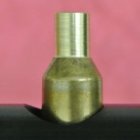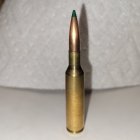You are using an out of date browser. It may not display this or other websites correctly.
You should upgrade or use an alternative browser.
You should upgrade or use an alternative browser.
Please will someone show me what donuts are and how do they occur.
- Thread starter Campbell
- Start date
Many sincere thanks
I don't trust "goggle" searches, especially when reloading is concerned. It's similar to googling on medical questions, so therefore, I prefer to ask informed folk on a topic related forum.
I think I can now see the reason for the problem: because the turned length of the neck is too short, the shoulder may not be fully against the chamber
I don't trust "goggle" searches, especially when reloading is concerned. It's similar to googling on medical questions, so therefore, I prefer to ask informed folk on a topic related forum.
I think I can now see the reason for the problem: because the turned length of the neck is too short, the shoulder may not be fully against the chamber
actually it is the thicker shoulder brass migrating into the neck after repeated cycles of sizing and firing. that is why when you turn necks you want to cut slightly into the shoulder. thin that shoulder brass that will soon become neck.
different case shapes have different rates of migration. you can tell by how often you have to trim. 30 degree and less shoulders usually will migrate at a greater rate than a 40 degree. some 40 cases never need trimming during the life of the case and rarely have donuts.
different case shapes have different rates of migration. you can tell by how often you have to trim. 30 degree and less shoulders usually will migrate at a greater rate than a 40 degree. some 40 cases never need trimming during the life of the case and rarely have donuts.
NorCalMikie
Gold $$ Contributor
And if you start forming donuts in the neck area, you CAN go with flat base bullets and seat "just above" the donut. It's also easy to run a mandrel into the neck, push the formed donut to the outside of the neck and turn it off.
Depending on your freebore, using different designed bullets will also let you seat above the donut. Something like VLD designed bullets. A boat tail design may have enough taper at the base to also let you seat above the donut. Keep playing till you find out what works best for you and your situation.
Depending on your freebore, using different designed bullets will also let you seat above the donut. Something like VLD designed bullets. A boat tail design may have enough taper at the base to also let you seat above the donut. Keep playing till you find out what works best for you and your situation.
6MMsteve
Gold $$ Contributor
you can get them also from bushing dies squeezing down the neck, you will know when you have them on a fired case, just push a bullet down the nk and you will feel the dreaded rasberry rotten cherry donuter at the base of the nk..... it's like hitting a rock wall then you explode in flames lol
If I end up with doughnuts (because I was afraid of cutting too deep for fear of a "neck separation" failure), is there a downside to simply cutting out the doughnut, as opposed to using a mandrel and turning the neck again?
K&M offers a carbide cutting pilot for their neck turner. https://www.midwayusa.com/product/6249283077/k-and-m-carbide-cutting-pilot
K&M offers a carbide cutting pilot for their neck turner. https://www.midwayusa.com/product/6249283077/k-and-m-carbide-cutting-pilot
Dusty Stevens
Shiner
If I end up with doughnuts (because I was afraid of cutting too deep for fear of a "neck separation" failure), is there a downside to simply cutting out the doughnut, as opposed to using a mandrel and turning the neck again?
K&M offers a carbide cutting pilot for their neck turner. https://www.midwayusa.com/product/6249283077/k-and-m-carbide-cutting-pilot
The only problem with that k&m cutting pilot is it leaves beautiful acme threads inside your necks. Best thing to do with donuts is ignore them and be glad your gunsmith was smart enough to make your bullet seat above them
you can get them also from bushing dies squeezing down the neck, you will know when you have them on a fired case, just push a bullet down the nk and you will feel the dreaded rasberry rotten cherry donuter at the base of the nk..... it's like hitting a rock wall then you explode in flames lol
I'm curious as to whether pushing a bullet into the neck of a fired piece of brass will detect a donut if neck tolerance is 'loose', for example if fired brass neck diameter is > 0.006" over loaded brass (bullet seated) neck diameter? This is exactly how I've found out I've had donut issues (pushing a bullet down the neck of a fired piece of brass and having it come to a HARD stop when the bearing surface contacts the neck-shoulder junction), but this has always been detected in my custom chambers with 0.003" - 0005" neck diameter clearance (so actual 0.0015" - 0.0025" neck clearance-per-side). Wonder if I'm missing donut issues on my sloppier chambers? Maybe using an appropriate-sized pin gauge would be a better tool?
As far as dealing with donuts and their problems; I've used a Wilson inside neck reamer on my neck trimmer set-up to ream them out. I've had very little luck using their off-the-shelf inside reamers, with them either not cutting out the donuts or with them taking out neck material and/or scoring the inside of the necks. I've had better luck sending brass with donuts into Wilson and having them make a custom inside neck reamer, but even that has not always worked out perfectly. The best solution is to select a bullet that seats where you want it to with respect to the lands, with the bearing surface ahead of the N-S junction. To avoid problems I now specify the freebore I want for the bullet/s I intend to shoot when the barrel is chambered and choose cartridges that allow this to be accomplished. It's been my experience that only a good gunsmith or owning your own reamer will reliably accomplish this. Some cartridges like 260 Remington, 338 Lapua, 223 Remington, etc will be very hard to find bullets for that feed from a magazine and still seat ahead of the N-S junction, others like 6.5x47 Lapua, 6mm BR, etc will be much easier to accomplish this with.
Even when seating ahead of the N-S junction, there can still be issues from donuts, depending on your reloading process. I've seen very high runout induced when sizing brass with donuts using an expander ball, and to a lesser degree when using a mandrel. I've had better results using a bushing die, bushing-only and not touching the inside of the neck on brass that has had donuts/donut issues, even on unturned brass.
I've also found recently that the relationship between a chamber and the sizing die can contribute to donuts forming excessively fast (its my belief that it's not a matter of IF a donut will form, it's a matter of when and how severe). I had a custom chambered 6.5 X 47, sized with a Forester FL bushing die, that would create donuts at an alarming rate. Even after reaming a donut out, it would be back after one firing cycle. Virgin brass would develop a donut after the second firing cycle. When I switched to a custom Harrels sizing die, the donuts practically went away.
Last edited:
Brass moves and happens in all calibers. Some reloaders don't worryI've only been reloading for about 4 years now and have not run into this situation or even heard of it. What caliber does this happen to or does it happen to all bottlenecks at some point?
about it if their bullets are above the neck/shoulder junction. For the
longer VLD's and hybrids that are loaded in short throated chambers,
the bullets are forced past the donut and screws up neck tension.....
JEFFPPC
Gold $$ Contributor
As stated above this will not happen if the chamber was properly throated for the bullet of choice. I question "gunsmiths" who do this. Of course I am speaking in terms of the various percision games using single shot actions.Brass moves and happens in all calibers. Some reloaders don't worry
about it if their bullets are above the neck/shoulder junction. For the
longer VLD's and hybrids that are loaded in short throated chambers,
the bullets are forced past the donut and screws up neck tension.....
Campbell -As per the above-mentioned.
Many thanks in advance.
Howdy !
Please take as info....
When " wildcatting " a case by necking down the brass to smaller calibre, a result in quite often the formation of " doughnuts ".
When really thick neck walls are the result of the neck down process, they may have to be addressed by a combination inside neck " ream " / outside neck turn. That's what I do when forming my wildcat " DEEP 6 ".
With regards,
357Mag
Attachments
Similar threads
- Replies
- 1
- Views
- 297
- Replies
- 13
- Views
- 1,403
Upgrades & Donations
This Forum's expenses are primarily paid by member contributions. You can upgrade your Forum membership in seconds. Gold and Silver members get unlimited FREE classifieds for one year. Gold members can upload custom avatars.

Click Upgrade Membership Button ABOVE to get Gold or Silver Status.
You can also donate any amount, large or small, with the button below. Include your Forum Name in the PayPal Notes field.
To DONATE by CHECK, or make a recurring donation, CLICK HERE to learn how.

Click Upgrade Membership Button ABOVE to get Gold or Silver Status.
You can also donate any amount, large or small, with the button below. Include your Forum Name in the PayPal Notes field.
To DONATE by CHECK, or make a recurring donation, CLICK HERE to learn how.













